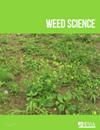华盛顿西北部两年秋季覆盖作物对冬季杂草种群的影响
IF 2.1
2区 农林科学
Q2 AGRONOMY
引用次数: 0
摘要
覆盖种植是一种被广泛研究的土壤保持措施。覆盖作物抑制杂草,通常是综合杂草管理计划的一部分,可以减少除草剂的使用,并可能减少杂草种子库。冬季芸苔覆盖作物在华盛顿东部马铃薯(Solanum tuberosum L.)产区很受欢迎,但在华盛顿西部,芸苔种子作物的生产存在病害问题以及异花授粉的风险,这限制了芸苔覆盖作物的使用。本文的研究于2018年至2020年和2019年至2021年在华盛顿州弗农山进行了两次试验,以确定与华盛顿州西部种植系统的区域限制和气候挑战相适应的冬季覆盖作物。研究了无覆盖对照、8种单种(包括芸苔、禾草和豆科)和草-豆科混合处理。测量了覆盖作物和杂草的生物量产量,并估算了不同物种覆盖作物和杂草的土地覆被百分比。覆盖作物生物量和杂草抑制因环境的不同而不同,但一年生黑麦草(Lolium multiflorum Lam.)和混交种在各年产生大量生物量和减少杂草生物量和覆盖方面最为一致。在每年的控制范围内,将杂草覆盖归一化,改善了杂草覆盖百分比对环境响应的变异性。本文章由计算机程序翻译,如有差异,请以英文原文为准。
Impacts of Two Years of Autumn Cover Crops in Northwestern Washington on Winter Annual Weed Populations
Abstract Cover cropping is a suggested soil conservation practice widely investigated in cropping systems. Cover crops suppress weeds and often are part of an integrated weed management plan that could lead to reduced herbicide use and possibly reduce the weed seedbank. Winter brassica cover crops are popular in the eastern Washington potato (Solanum tuberosum L.) production region, but in western Washington, the production of brassica seed crops presents disease issues along with the risk of cross-pollination, which limits the use of brassica cover crops. Research for this article was conducted in two trials from 2018 to 2020 and 2019 to 2021in Mount Vernon, Washington, to identify winter cover crops compatible with regional restrictions and climatic challenges in western Washington cropping systems. Treatments including a no-cover control, eight single species (including brassicas, grasses, and legumes), and a grass–legume mixture were investigated. Cover crop and weed biomass production were measured, and percent ground cover for cover crops and weeds by species was estimated. Cover crop biomass and weed suppression varied by year due to variable environments, but annual ryegrass (Lolium multiflorum Lam.) and the mixture were most consistent in producing large amounts of biomass and reducing weed biomass and cover in all years. The variability of percent weed cover response to environment was ameliorated when weed cover was normalized within each year's control.
求助全文
通过发布文献求助,成功后即可免费获取论文全文。
去求助
来源期刊

Weed Science
农林科学-农艺学
CiteScore
4.60
自引率
12.00%
发文量
64
审稿时长
12-24 weeks
期刊介绍:
Weed Science publishes original research and scholarship in the form of peer-reviewed articles focused on fundamental research directly related to all aspects of weed science in agricultural systems. Topics for Weed Science include:
- the biology and ecology of weeds in agricultural, forestry, aquatic, turf, recreational, rights-of-way and other settings, genetics of weeds
- herbicide resistance, chemistry, biochemistry, physiology and molecular action of herbicides and plant growth regulators used to manage undesirable vegetation
- ecology of cropping and other agricultural systems as they relate to weed management
- biological and ecological aspects of weed control tools including biological agents, and herbicide resistant crops
- effect of weed management on soil, air and water.
 求助内容:
求助内容: 应助结果提醒方式:
应助结果提醒方式:


